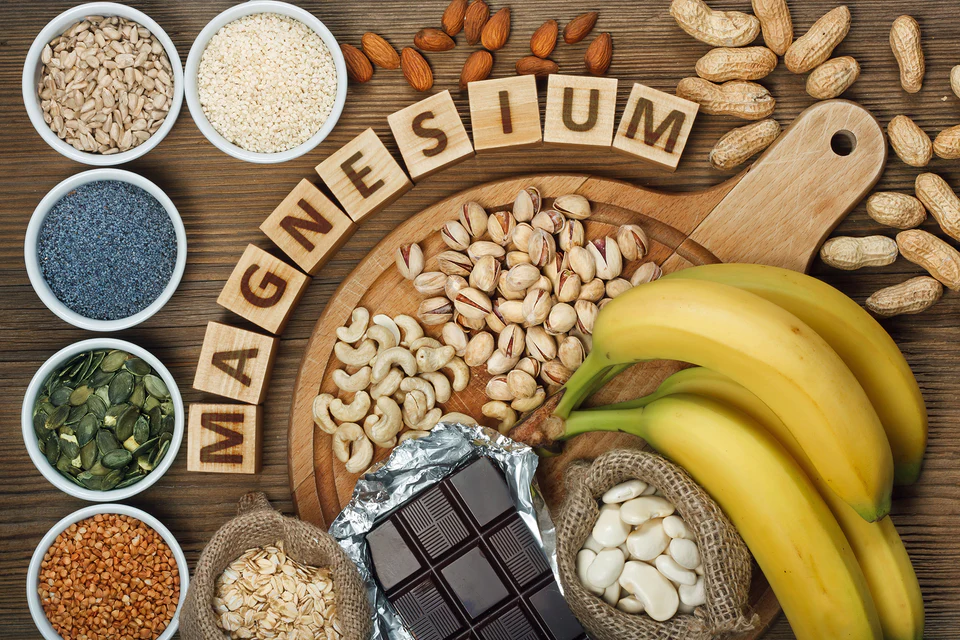Calcium
Calcium in the body must be tightly controlled because it is necessary to cell function for such things as blood clotting, muscle contraction, enzyme reactions, cellular communication and skin differentiation. It also gives bones and teeth their strength.
Calcium is rather deficient in the environment. The body has developed special mechanisms to extract calcium from dietary sources. Normal adults adapt to decreased calcium intake by increasing the fraction of dietary calcium absorbed, but absorption is impaired by aging. Some 30-60% of dietary intake is normally absorbed. Several hormones are involved in calcium metabolism. Two protein hormones, parathyroid hormone and calcitonin, and a derivative of Vitamin D act to make sure the body optimally assimilates dietary calcium. A deficincy of calcium results in rickets in children and osteomalacia, both of which display a lack of bone mineralization. Calcium deficiency may also contribute to osteoporosis. Toxicity is rare except in certain diseases involving vitamin D or the parathyroid gland.
Dietary sources of calcium are mostly from the dairy foods. However, meat, some beans, seafood, tofu, and green leafy vegetables contain substantial amounts of calcium. 72% of the calcium available from dietary sources is from the dairy group. Unless an individual has an adverse reaction to milk’s components (e.g., lactose intolerance) milk consumption is encouraged. RDA is at least 1100mg/day for adult women and1600 mg/day for those age 11 to 24 and for pregnant or breastfeeding women.
Phosphorus
Phosphorus is present in the body as inorganic phosphate or phosphate esters, and has many biological roles. Like calcium, the active form of vitamin D regulates phosphorus absorption. It is important for carbohydrate metabolism, cell membrane structure, transport processes, muscle function, and energy storage. Energy is stored in the form of adenosine triphosphate (ATP) which is used to fuel many biological processes. Phosphorus is present in nucleic acids and as a structural component of bones and teeth. The phosphate buffer system is important in maintaining the narrow pH range that is necessary for life. The widespread abundance of phosphorus in food makes a deficiency uncommon except in certain diseases. With excessive intake of aluminum, calcium or magnesium containing antacids or laxatives, a phosphate deficiency can occur because these substances prevent phosphate from being absorbed from the intestine.
Phosphorus containing laxatives are often used before surgery or x-ray of the intestines. Sodium phosphate increases the amount of water in the bowel that then stimulates bowel stretch receptors and increases muscle contractions of the intestines. Given as an enema, sodium phosphate primarily promotes evacuation of the colon.
The use of phosphate supplements by athletes as a power enhancer is controversial, although some studies suggest it improves aerobic performance. The effects of chronic supplementation is not known, however it is not recommended due to the potential to affect calcium metabolism, bone mineralization, and magnesium balance.
The RDA of phosphorus for males and females over 18 years is 700 mg. At high doses it may cause nausea, diarrhea, cramps, muscle paralysis, mental confusion, high blood pressure and abnormal heart rhythms. High levels of phosphate in the blood can cause precipitation of calcium as calcium phosphate in places other than bone and result in low levels of calcium in the blood. Low levels of calcium in the blood can cause tetany, which is characterized by tremor, seizures, muscle cramps, abnormal nerve sensation, and shortness of breath. Many cola drinks contain a high amount of phosphate and high consumption of these drinks can result in high phosphate and low calcium in the blood. People with osteoporosis are advised to limit their consumption of these beverages due to their effect on calcium balance.
Magnesium
Magnesium works in conjunction with many enzymes that are involved in energy metabolism, protein synthesis and nucleic acid synthesis. Magnesium supplements are available as several salts (chloride, gluconate, lactate, sulfate and oxide) and are used to treat people with magnesium deficiency due to poor nutrition, restricted diet, alcoholism, or magnesium-depleting drugs. Many antacids or laxatives also contain magnesium. It is sometimes given IV during pregnancy to control eclamptic seizures and to inhibit uterine motility during premature labor. Large doses can lower blood pressure and cause depression of the central nervous system.
Recently magnesium supplements have gained popularity for several unapproved uses. Many patients with migraine headaches have been found to have low levels of magnesium ions. Magnesium supplements appear to decrease the incidence of migraine attacks in certain people. Oral magnesium may be helpful in preventing premenstrual or menstrual migraines. It may also minimize premenstrual mood changes and fluid retention. When used IV under medical supervision, magnesium may be used to treat cluster migraines. Magnesium supplements should only be used under medical supervision in the presence of heart disease or kidney impairment.
A deficiency of magnesium is rare. Drugs that cause potassium depletion, such as certain diuretics, may also cause low magnesium levels. A deficiency can occur in diabetics, alcoholics and in the presence of gastrointestinal disorders where absorption is impaired, such as prolonged diarrhea. Magnesium appears to be involved in the regulation of calcium levels; therefore if magnesium levels are low, calcium levels may also be low and unresponsive to treatment unless magnesium levels are corrected. Signs of a deficiency include loss of appetite, irritability, disorientation, convulsions, and abnormal behavior.
The RDA of magnesium for males 31 years and older is 420 mg; for women 31 years and older, 320 mg; for pregnant women 19-30 years, 350 mg; and for lactating women 19-30 years, 310 mg.
Sodium
Sodium acts to maintain the normal hydration state of the bodily fluids. Sodium ions are found primarily in the plasma and fluid surrounding cells while potassium is found within cells. These ions affect the movement of water in an out of cells. Sodium ions balanced by other ions are necessary to normal cell function in all tissues of the body.
Sodium, chloride and potassium concentrations are tightly controlled by osmoreceptors within the brain and the hormones ADH and aldosterone. These ions can be resorbed from or exceted in the urine, sweat, tears as needed. One to 2 grams of sodium is found in the normal diet. We require an intake of about 4-6 grams each day. Because sodium is added to many foods during processing as a flavor enhancer, intakes in the U.S. are often in excess of the requirement. Sodium may be involved in hypertension in some individuals.
Potassium
Potassium is essential to energy metabolism and to glycogen and protein synthesis. Because of its role in neuromuscular conduction, high or low levels of potassium can be life threatening. Too little potassium (hypokalemia) results in cardiac arrhythmias, muscle weakness, sodium loss in the urine, alterations in acid base balance and the inefficient use of carbohydrate. Too much potassium (hyperkalemia) requires immediate medical attention because the heart may fail to beat normally or at all.






